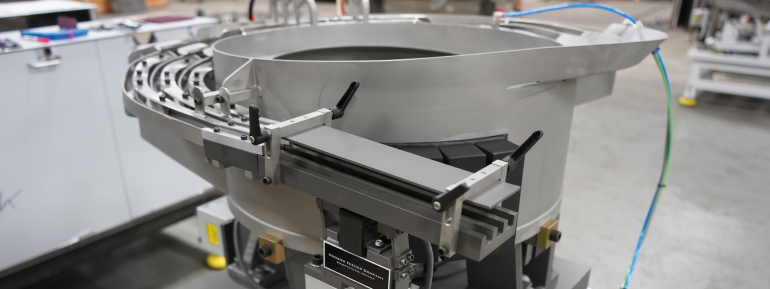Hoosier Feeder Company creates vibratory feeder systems for several industries, including automotive and consumer packaging. A quality vibratory feeder system enables companies to sort even the most complicated parts. While many customers understand the need for a vibratory system – to orient and discharge parts in a repeatable position for optimal efficiency – some are unfamiliar with the elements of a system that are most crucial to its design.

Here are the most important components of a vibratory feeder system:
- Basic Bowl – The bowl of a vibratory feeder system is the main interior component. This feature also includes the shell and track. The bowl must be designed to fit each individual part while having enough capacity and spiral track. The bowl must also be large enough to handle the number of parts you need to output. The pitch of the internal track is what enables parts to travel up the track in a smooth and precise motion without suffering from dead spots. The total number of tracks, or turns, must also be considered. Proper band height is another key design issue. The feeder bowl needs to be the right height to allow operators to efficiently do their job. At the same time, allowances for tooling need to be accounted for to enable parts to move through the feeder system and be oriented correctly.
- External Tooling – After the design of the basic bowl, you need to turn your attention to the mechanical toolings of the feeder. The external tooling manipulates and selects the parts before presenting it to the next stop in the process.
- Linear Track – Delivers oriented parts to the next step of the assembly process. A track must be designed properly to feed the parts to the line. It must be constructed from high quality materials to maximize the components life expectancy. A linear track must include design features such as clean-outs to simplify the process for operators to run and maintain the system.
- Proper Controls and Photo-Optics – Your entire feeder system must operate in complete synergy. Controls and photo-optics ensure all the components do so. Controls and photo-optics monitor and control the flow of the parts through the system. There are multiple options when it comes to control and sensors; control packages can directly affect the success of the system.
- Machine Base – The table a vibratory feeder sits on must be flat and of solid construction. The machine base also needs to be designed to provide the most access possible for system operators. Not taking the time to ensure your machine base is of the highest quality will lead to integrity issues down the road.
- Pre-Feeder – Pre-feeders come in various shapes and sizes, including supply hoppers, elevators, and so on. The pre-feeder must fill the bowl on demand, ensuring proper supply ratios in the feeder system so the system operates correctly. Choosing the right pre-feeder, based on the size, style of the part and capacity required for the system.
- Shuttle or Escapement Mechanisms – Vibratory feeder systems occasionally require additional components such as shuttle or escapement mechanisms. Part design will drive the ability to put the part in a dead nest or isolation mechanism for customer pick up.
Organizations that understand the main components of a vibratory feeder system are in a better position to participate in the design of a solution to maximize efficiencies. Does your company rely on vibratory systems as part of its manufacturing process?
Click here to contact Hoosier Feeder Company today to learn more about our services.
October 3, 2016
Related Topics: Vibratory Feeders